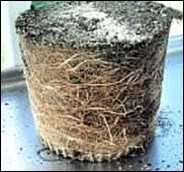I hope World Naked Gardening Day met all your expectations.
In the last article I wrote about proper planting. However there is something else you need to know if you are buying trees and shrubs that are in pots – circling roots.
When you remove the tree or shrub from the nursery pot it will probably have root growth that follows around the shape of the pot. Well, everybody knows that if the tree or shrub was growing naturally, the roots would not do this. Roots gather moisture and nutrients from the soil and provide stability for the plant. Knowing this, the further the roots can spread, the better access the plant has to moisture, and nutrients. And even a municipal engineer can’t argue with the fact that more anchor points (roots) over a wider space will help the tree stand up straight and be more stable.
In order for your containerized tree or shrub to really thrive, you must remove the container and tickle the roots prior to planting to break up the circling root pattern and encourage more natural rooting.
Dr. Ed Gilman from the University of Florida states, “slice the sides of the container root ball as deeply as possible to sever circling roots. Also cut kinked and circling roots that occur on the top of the container. This will reduce likelihood of the tree dying from these severe root defects later. In most cases there is little or no negative impact on the tree from this aggressive root cutting, as long as trees are irrigated. The positives far outweigh the negatives.”
So if you don’t want to subscribe to what the researcher suggests then at the very least you should be grabbing those circling roots with your fingers and firmly pulling them out of their circling pattern prior to planting. Dr. Ed being from Florida shouldn’t eliminate the validity of his planting advice. Trees grow similarly and have similar requirements wherever they grow. The species of trees, of course, will differ.
Girdling roots:
Last article I talked about root flare or buttress roots. These are the ones that are visible at the bottom of the trunk just before the roots enter the soil.
When you take your new tree from its pot you must inspect the root flare to see if there are any other roots growing over top of the flare roots. If there are roots over top of the flare roots, you must carefully remove them. Girdling roots become a bigger problem with time and can become a major defect in the tree, potentially causing death of the tree or causing the tree to break off at the girdled point in a storm.
Parting advice – Pinch your candles
Have you ever bought a mugo pine all dense and compact looking, planted it by your house only to watch it become long and leggy and somewhat ugly?
Well, once per year, right about now, mugos send out growth points or candles that are the new growth for the season. If you pinch these candles and remove the growing points, the mugo will stay much more dense and compact.



